Key takeaways:
- Understanding audience preferences is crucial, as they can shift rapidly, influenced by emotional connections and seasonal changes.
- Engaging directly with the audience through polls and conversations reveals valuable insights and fosters stronger relationships.
- Adapting to trends, such as genre blending and incorporating visual elements, enhances audience connection and encourages artistic innovation.
- Transparency about creative processes and sharing personal experiences can build trust and deepen audience engagement.
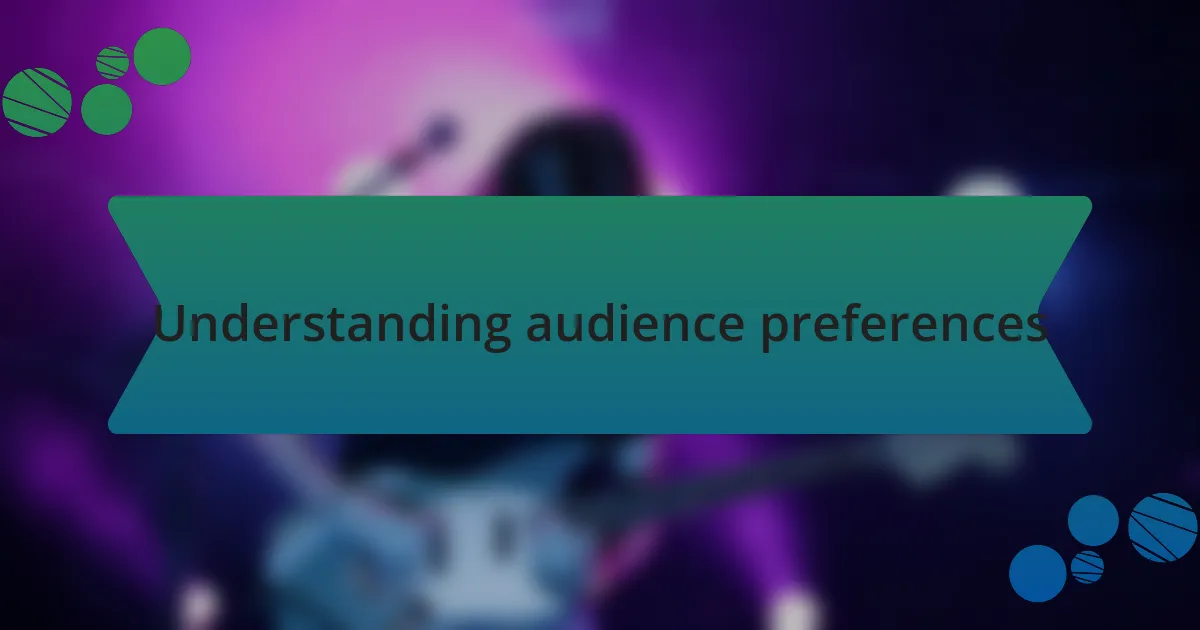
Understanding audience preferences
Understanding audience preferences requires a thoughtful approach. I remember when I first noticed a shift in what my listeners were craving—one moment, it was all about underground beats, and the next, they were raving about pop-infused tracks. This change caught me off guard, but it highlighted just how dynamic our audience can be. Why do you think preferences evolve so quickly in the electronic music scene?
Digging deeper into these preferences often reveals emotional connections. I’ve had fans share how a particular track brought back memories of special moments or how a specific beat can elevate their mood during tough times. It’s fascinating to see how music intertwines with personal experiences. Do you sometimes wonder what stories lie behind the playlists we curate?
Engaging with the audience is another crucial step. I often find that hosting Q&A sessions or even simple polls can offer valuable insights into the shifting tastes of our listeners. When was the last time you asked your audience what they truly want? By actively listening and adapting, we not only grow our community but also foster a deeper connection through our music.
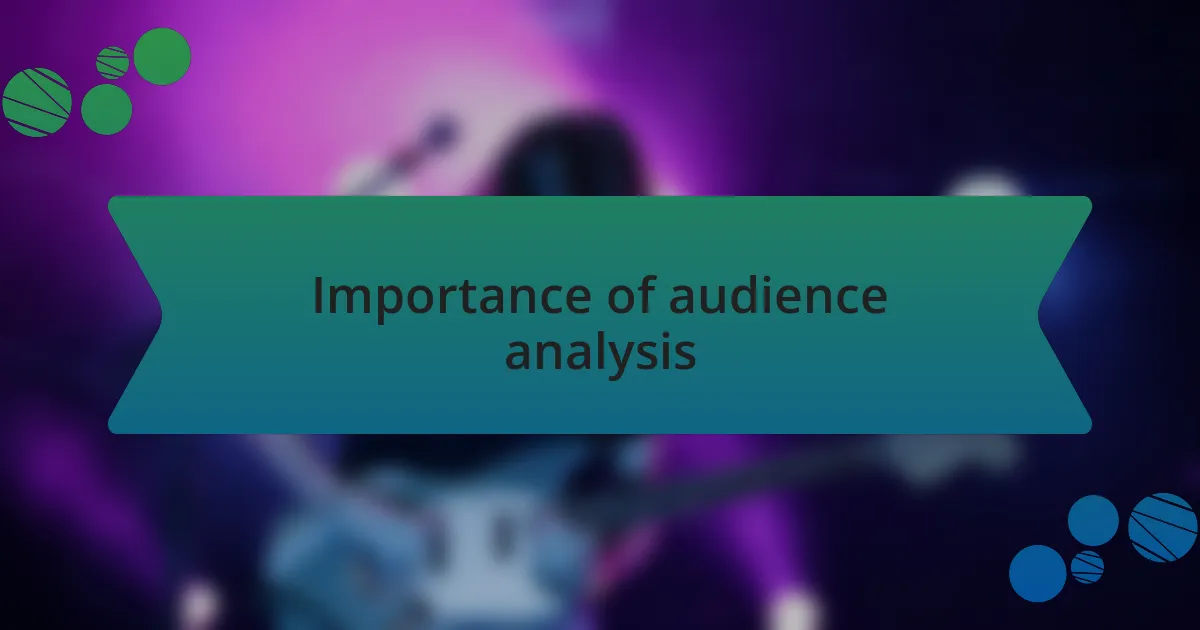
Importance of audience analysis
Audience analysis is critical for staying relevant in the fast-paced world of electronic music. I recall a time when I shifted my promotional strategies after realizing that my followers were gravitating towards more melodic tunes rather than the heavier drops that once defined our label’s identity. This insight truly reshaped our music selections and marketing, emphasizing that understanding your audience is not just beneficial—it’s essential.
It’s amazing how subtle changes in audience preferences can have a ripple effect on an entire music label. In my experience, I’ve seen that an audience’s mood can shift with the seasons. For instance, summer vibes often lean towards upbeat tracks perfect for festivals, while winter could crave deeper, reflective sounds. Have you ever considered how these fluctuations can directly influence your releases and promotions?
Listening to my audience led me to a unique opportunity: collaborating with voices from various sub-genres. Through polls and feedback, I found emerging artists that resonated with our fans. It felt exhilarating to break away from our usual style and explore these new avenues. When was the last time you let your audience’s voice guide your journey? Engaging them not only deepens your connection with them but also allows for fresh, innovative paths to emerge in your musical endeavors.
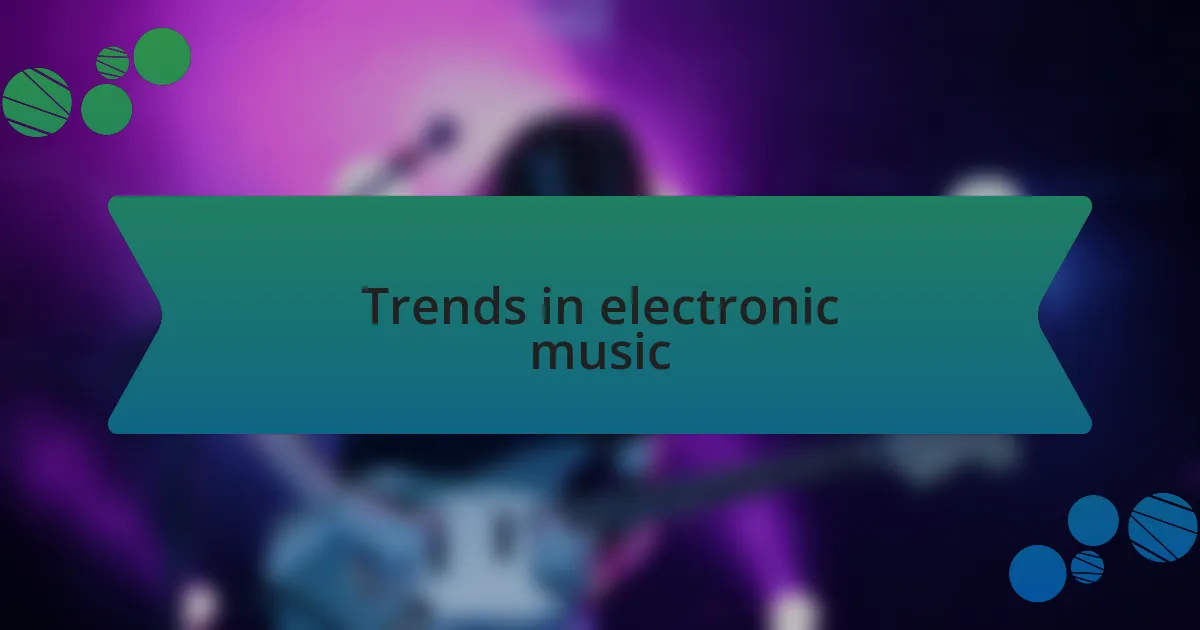
Trends in electronic music
As the landscape of electronic music continues to evolve, I’ve noticed a fascinating blend of genres emerging. One moment, house beats may dominate, while the next, experimental sounds surge to the forefront, creating a melting pot of styles. It’s a reminder that trends can be fluid; they shift not only from year to year but even from month to month. Have you felt that tug to incorporate elements from different genres into your work? I certainly have, and it has led to some of the most rewarding experiences in my career.
Another trend I observe is the increasing influence of social media on music consumption. Platforms like TikTok have become hotspots for discovering new tracks, often propelling lesser-known artists into the limelight overnight. It’s incredible to think how a short clip can turn a song into a viral sensation. I still remember the day I saw one of our tracks trending—the excitement was palpable. How often do you think about how your audience encounters your music in these rapidly changing digital spaces?
Moreover, sustainability and wellness are becoming central themes within the electronic music community. Festivals are now integrating eco-friendly practices, and artists are increasingly focused on creating music that promotes positive energy and healing experiences. When I recently participated in an event prioritizing sustainability, the atmosphere felt different—more connected and purpose-driven. Isn’t it inspiring how music can serve as a beacon for change and reflection? Embracing these trends not only enriches our art but also aligns us with the values of our listeners.
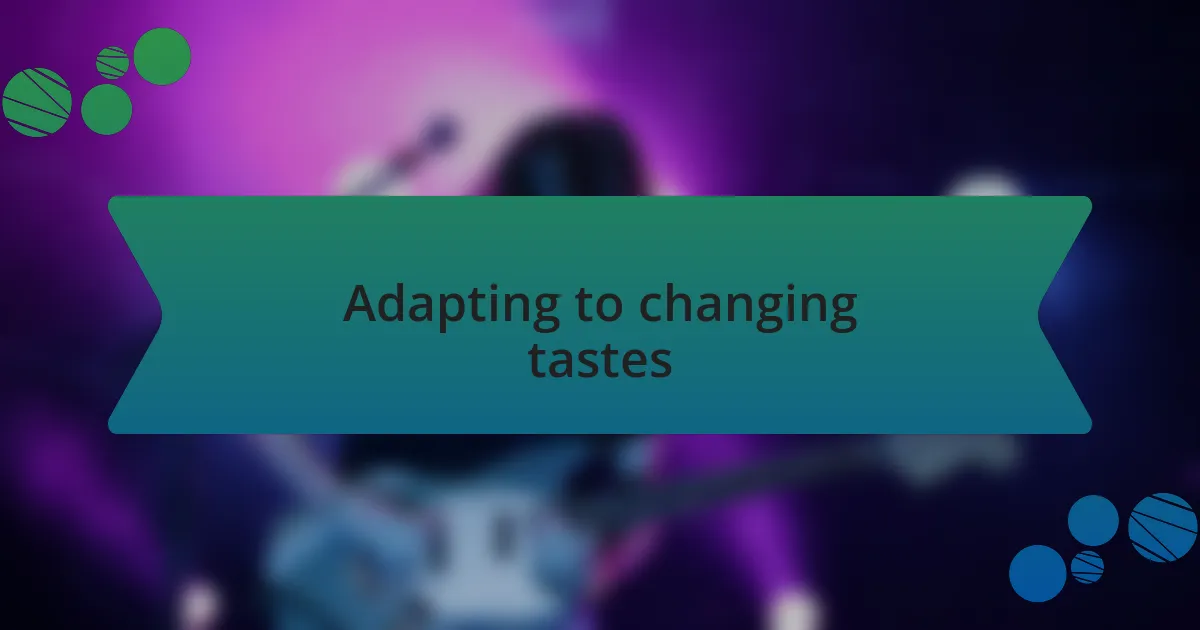
Adapting to changing tastes
Adapting to changing tastes requires a keen ear and an open mind. I recall a time when I released a track that I thought would resonate well with my audience, only to find that it didn’t quite hit the mark. It was disheartening at first, but I realized that instead of dwelling on the failure, I needed to listen more closely to what my listeners wanted. Have you ever found yourself in a similar situation where you had to adjust your approach based on feedback?
As dynamics in electronic music shift, I’ve taken the humble step of engaging directly with my audience. Social media polls or casual conversations at shows have become invaluable tools for gauging preferences. This direct interaction has revealed surprising favorites that I wouldn’t have guessed otherwise. It’s as if the audience provides a mirror that reflects where I should be focusing my creative efforts. Isn’t it fascinating how a simple question can ignite a wave of inspiration?
Moreover, experimenting with genres has led to some unexpected and delightful outcomes. I vividly remember blending elements of trance with ambient influences in a recent project. The positive response was overwhelming and made me realize that my audience craves innovation as much as they enjoy familiarity. Have you explored unexpected combinations in your work? In the ever-evolving world of electronic music, staying attuned to these changes helps not only in meeting audience expectations but also in discovering your own artistic voice.
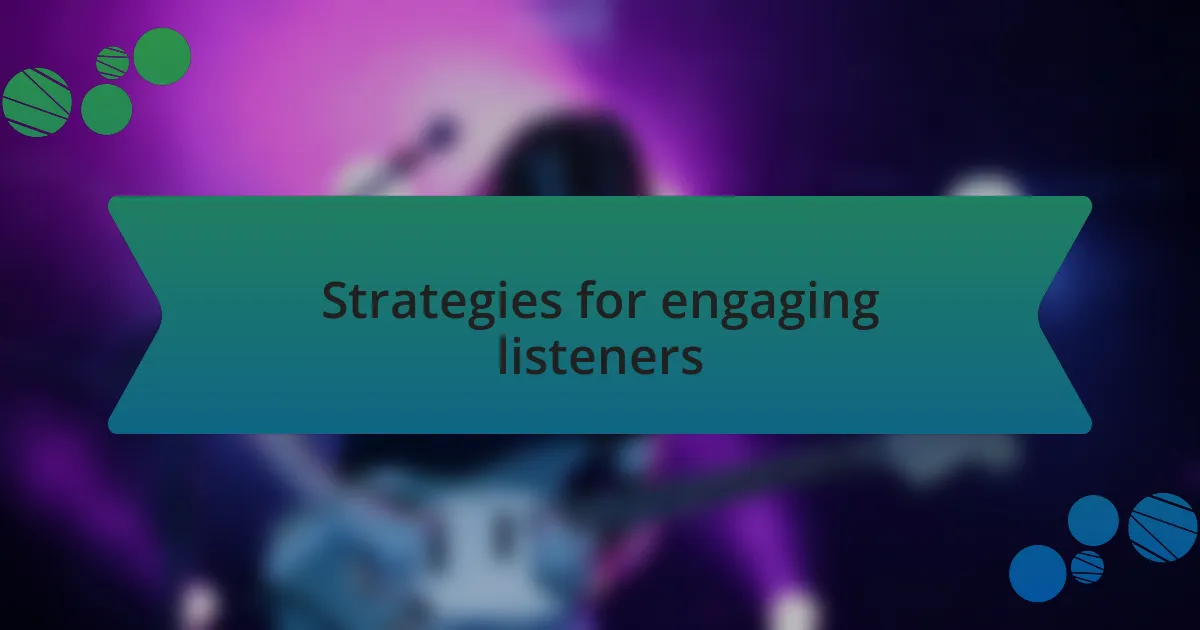
Strategies for engaging listeners
One effective strategy I’ve found for engaging listeners is to curate experiences that go beyond just sound. I once hosted a listening party that not only featured new tracks but also visually enhanced the experience with immersive lighting and art. The energy in the room was electric, and it struck me how much deeper the connection became when I considered all senses. Have you ever thought about how visuals might elevate your own musical presentations?
Collaboration is another powerful way to resonate with an audience. I remember teaming up with a fellow artist who had a completely different style than mine. The collaboration not only expanded my reach but also introduced my existing listeners to fresh sounds. It made me realize that opening up creatively allows for growth—not just for me, but for the audience as well. Wouldn’t you agree that collaborating could be a game-changer in your own projects?
I’ve also come to appreciate the importance of storytelling through music. Each track can tell a story, and during live sets, I often share the inspiration behind specific songs. When I opened up about my creative process during one performance, I noticed how receptive the crowd became—it was almost as if they felt personally invested in the music. This connection is invaluable. Do you find that sharing your journey adds depth to your work?

Personal experiences in audience shifts
Shifts in audience preferences can sometimes feel like navigating a moving target. I recall a time when my audience was predominantly into deep house, but then, suddenly, they began gravitating towards the more energetic genres like techno. It left me pondering: how do I adapt without losing my core essence? Engaging in conversations with fans was crucial; their feedback provided clarity on what they were seeking.
There was this one festival where I tried out a new sound that blended my original style with the prevailing trends. The crowd’s excited response was almost overwhelming. I realized that being open to experimentation not only keeps the audience engaged but can also invigorate my creativity. Have you ever taken a risk in your music that paid off unexpectedly?
On another occasion, I noticed a surge in requests for more personalized experiences. This led me to implement meet-and-greet sessions before my performances, allowing me to connect one-on-one with fans. I was genuinely thrilled to hear their stories and preferences firsthand. This not only shaped my setlist but also fostered a community feeling. Have you considered how direct engagement could reshape your understanding of your audience?
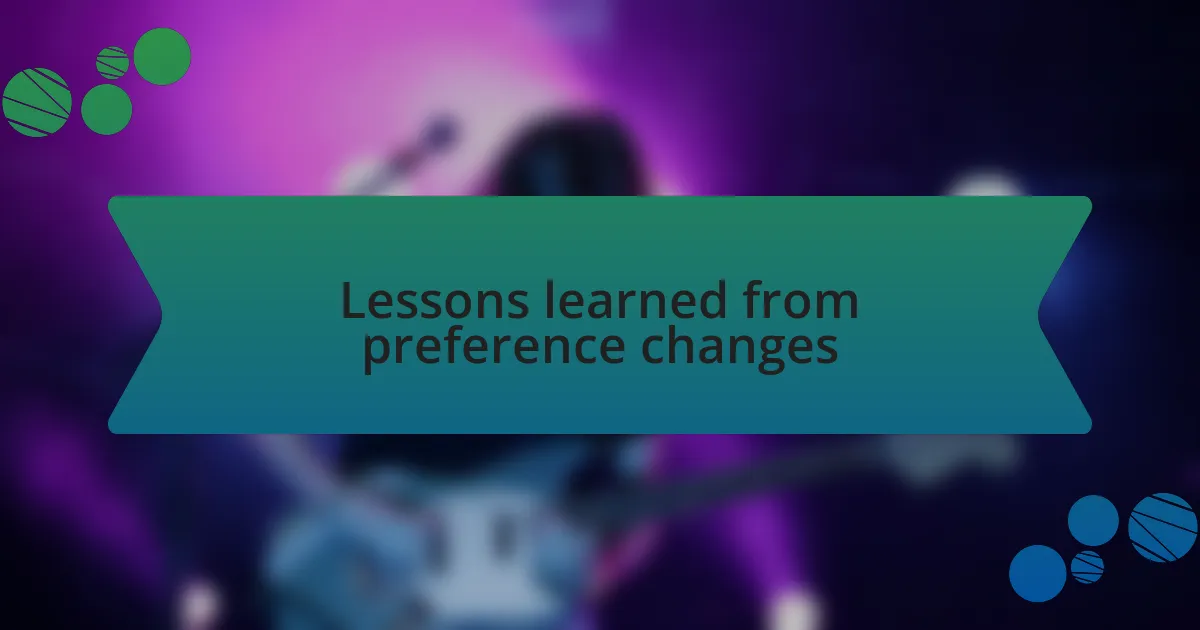
Lessons learned from preference changes
Recognizing shifts in audience preferences has taught me the importance of tapping into the emotional core of my listeners. For instance, I once experimented with a haunting vocal arrangement and noticed many fans posting, sharing, and discussing it in forums. That experience revealed how emotionally charged music can forge deeper connections. How often do we stop to consider what truly resonates with our audience beyond just beat and rhythm?
Another lesson I’ve learned is about staying agile in the face of change. I remember when there was a shift towards fusion genres; instead of resisting, I developed a collaborative track with an artist from a different scene. The unpredictable outcome surprised us both and broadened my reach. Have you ever thought about how collaboration can help you discover new dimensions in your own music?
Ultimately, transparency with my audience about these shifts has fostered a sense of trust. I began sharing my thought process and creative struggles through social media, and the response was heartwarming. Fans appreciated the insight into my journey. It made me wonder: how often do we overlook the value of sharing our experiences with those who support us?